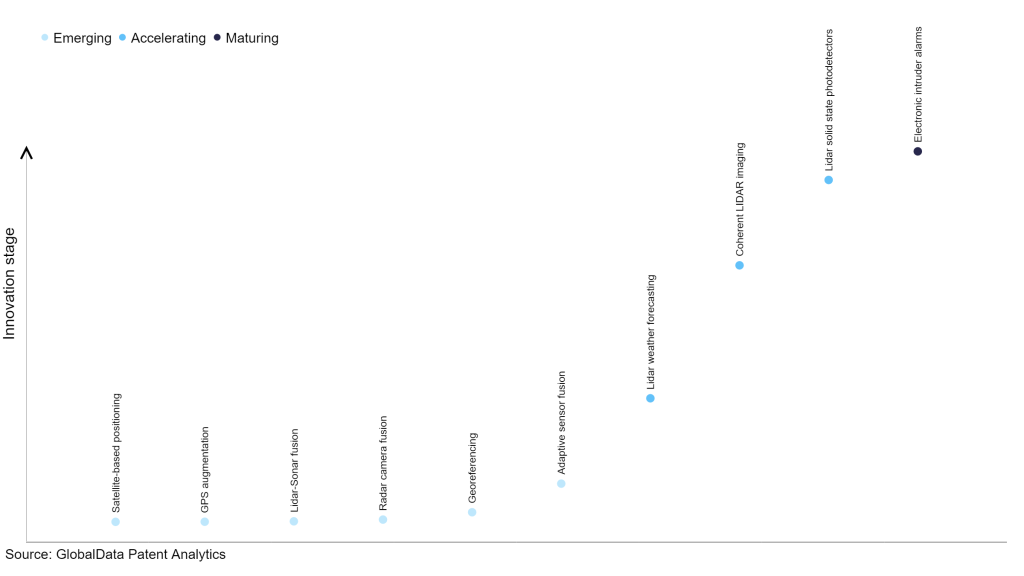The aerospace and defense industry continues to be a hotbed of patent innovation. Activity is driven by the pressing need for modernization, and the growing importance of technologies such as artificial intelligence (AI), Internet of Things (IoT), and unmanned systems. In the last three years alone, there have been over 237,000 patents filed and granted in the aerospace and defense industry, according to GlobalData’s report on Internet of Things in defense: radar camera fusion. Buy the report here.
However, not all innovations are equal and nor do they follow a constant upward trend. Instead, their evolution takes the form of an S-shaped curve that reflects their typical lifecycle from early emergence to accelerating adoption, before finally stabilizing and reaching maturity.
Identifying where a particular innovation is on this journey, especially those that are in the emerging and accelerating stages, is essential for understanding their current level of adoption and the likely future trajectory and impact they will have.
110 innovations will shape the aerospace and defense industry
According to GlobalData’s Technology Foresights, which plots the S-curve for the aerospace and defense industry using innovation intensity models built on over 206,000 patents, there are 110 innovation areas that will shape the future of the industry.
Within the emerging innovation stage, satellite-based positioning, GPS augmentation, and LiDAR-sonar fusion are disruptive technologies that are in the early stages of application and should be tracked closely. LiDAR weather forecasting, coherent LiDAR imaging, and LiDAR solid state photodetectors are some of the accelerating innovation areas, where adoption has been steadily increasing.
Innovation S-curve for Internet of Things in the aerospace and defense industry

Radar camera fusion is a key innovation area in Internet of Things
Radar camera fusion refers to the integration of radar and camera sensor data for the purpose of object detection, localization, and tracking in various applications. It involves combining the strengths of both sensors to improve accuracy and reliability in perceiving the surrounding environment.
GlobalData’s analysis also uncovers the companies at the forefront of each innovation area and assesses the potential reach and impact of their patenting activity across different applications and geographies. According to GlobalData, there are 90+ companies, spanning technology vendors, established aerospace and defense companies, and up-and-coming start-ups engaged in the development and application of radar camera fusion.
Key players in radar camera fusion – a disruptive innovation in the aerospace and defense industry
‘Application diversity’ measures the number of applications identified for each patent. It broadly splits companies into either ‘niche’ or ‘diversified’ innovators.
‘Geographic reach’ refers to the number of countries each patent is registered in. It reflects the breadth of geographic application intended, ranging from ‘global’ to ‘local’.
Patent volumes related to radar-camera fusion
Source: GlobalData Patent Analytics
Thales is one of the leading patent filers in radar-camera fusion. It has been granted patent for a method of merging data originating from at least two sensors such as radar, camera, and microphone, using a processor, which is configured to acquire the information or data from multiple sensors in a raw form and transform them into conceptual graphs. The information arising from these graphs can be merged as per the user preferences.
The company uses its multi-sensor data fusion expertise in developing advanced intelligence, surveillance, target acquisition and reconnaissance (ISTAR) systems. The Watchkeeper dual-sensor and all-weather tactical unmanned aerial vehicle (UAV) used by the UK armed forces was developed by Thales, in partnership with Israeli defense electronics company Elbit Systems. Equipped with Thales I-Master radar and high-performance electro-optical/infra-red (EO/IR) camera, the UAV can provide real-time, enhanced situational awareness and surveillance capability.
Some other key patent filers in the radar-camera fusion space include Boeing, Airbus, and General Dynamics.
In terms of application diversity, Diehl Stiftung, Boeing, and Airbus are some of the leading innovators. By means of geographic reach, some of the leading patent filers include General Dynamics, Diehl Stiftung, and Thales.
To further understand the key themes and technologies disrupting the aerospace and defense industry, access GlobalData’s latest thematic research report on Aerospace & Defense.
Data Insights
From

The gold standard of business intelligence.
Blending expert knowledge with cutting-edge technology, GlobalData’s unrivalled proprietary data will enable you to decode what’s happening in your market. You can make better informed decisions and gain a future-proof advantage over your competitors.



